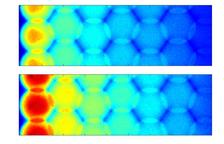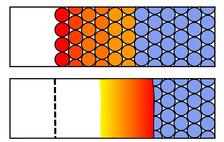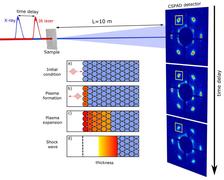The process in detail at the beginning. A projection of the electron energy density in the colloidal crystal as a result of simulations is shown here. Colloidal particles are represented by circles. Their colour corresponds to the temperature of the colloidal crystal: red is plasma and blue is the cold material. (Credit: from original publication, see below)
Hydrocarbons are one of the most common chemical species throughout the universe. A considerable amount of hydrocarbons exists due to the extreme pressure and temperature conditions (150 GPa and 5000 K) inside giant planets, especially inside icy giants such as Neptune and Uranus. Also, some extrasolar planets and white dwarf stars, are built from high-pressure carbon. In order to understand these planetary formations an international team, including scientists from DESY, tried to find ways to study hydrocarbons compressed to high pressures and heated to high temperatures under laboratory conditions.
Currently two major methods of generating extreme high pressure are used for experiments: the static compression with diamond anvil cells and the dynamic compression by creating shock waves. These shock waves can be generated, for instance, by powerful short-pulse lasers. Compared to the static compression experiments, the achievable pressure is much higher. The fundamental process caused by a high-power laser pulse is the creation of plasma at extreme temperature and pressure, which leads to a shock compression of the material. The shock wave speed is in the range of several kilometers per second, therefore, a facility providing picosecond time resolution is required for the in situ measurements of the shock-induced dynamics.
In particular, X-ray Free-Electron Lasers (XFELs), are well suited for time-resolved measurements of the ultrafast structural dynamics of laser-created plasma. The shock wave in the material is created by a high-power infrared (IR) laser. XFELs provide extremely intense coherent femtosecond X-ray pulses, which are necessary to perform experiments with the required time resolution. Although the scattering signal from the uniform plasma is not very high, sufficient response can be achieved if the plasma is periodically modulated in space. This feature enables the use of the powerful X-ray Bragg scattering and imaging techniques.
Such a unique form of matter as periodic plasma can be created, for example, by the high-power laser interaction with the periodically ordered dielectric material. Fascinating properties of this plasma are the enhancement of the generated intensity in the cases of low-order harmonic generation in comparison to uniform plasma. Moreover, the investigation of dynamics and properties of periodic plasma is beneficial for the development of new laser-based radiation sources. In this study periodic plasma was generated by the IR laser interaction with colloidal crystals made of polystyrene, a hydrocarbon polymer. The experiments were performed at the free-electron laser Linac Coherent Light Source (LCLS) at SLAC in Stanford (US).
The periodicity of the polystyrene sample allowed to apply the Bragg peaks analysis and to observe dramatic ultrafast changes in the colloidal crystal sample. For the experiment an IR laser with intensity of the order of 1014 W/cm2 was used. With such high intensities confined hot periodic plasma was created that generated a shock wave that compressed the surrounding pristine material. Pressures on the order of 100 GPa could be reached, triggering fast changes in the colloidal crystal structure. Short and long characteristic timescales were obtained corresponding to the ablation of the material and shock wave propagation, respectively. A good correspondence between the characteristic times determined in the experiment and in simulations was found. At the same time, simulations predict much shorter times of evolution of plasma and ablation processes in polystyrene colloidal samples. This is still an open and intriguing question of investigation of the plasma dynamics and ablation process with the sub-picosecond time resolution and will need special attention in future experiments.
The team, led by Ivan Vartaniants from DESY, demonstrated that the shock wave propagation inside the periodic colloidal crystal can be visualized in situ with a high temporal resolution by an IR pump – X-ray probe experiment at an XFEL facility The application of the ideas and methodology based on scattering from the periodic samples developed in this work may pave the way to new investigations of phase transitions in matter under extreme conditions.
Reference: Femtosecond laser produced periodic plasma in a colloidal crystal probed by XFEL radiation; N.Mukharamova, S. Lazarev, J.-M. Meijer, O. Yu. Gorobtsov, A. Singer, M. Chollet, M. Bussmann, D. Dzhigaev, Y. Feng, M. Garten, A. Huebl, T. Kluge, R. P. Kurta, V. Lipp, R. Santra, M. Sikorski, S. Song, G. Williams, D. Zhu, B. Ziaja-Motyka, T. E. Cowan, A. V. Petukhov and I. A. Vartanyants, Scientific reports (2020), DOI: 10.1038/s41598-020-67214-z









